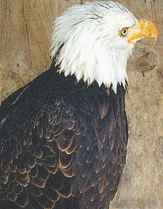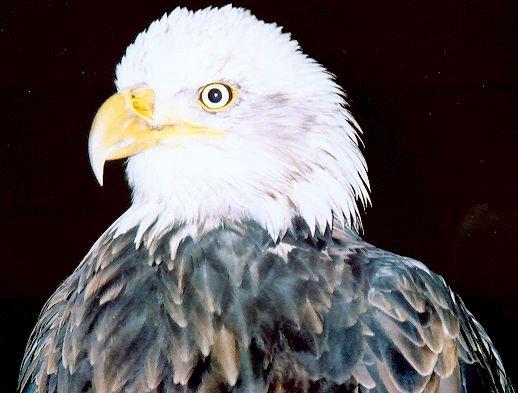|
|

Adult bald eagles have a
completely white head and tail, and an entirely yellow
beak. (Photo by Marcel Gahbauer)
|
|
The bald eagle is one of North America’s largest
raptors, with a wingspan of 180 - 225 cm, and a length from head
to tail of 70 - 90 cm. Their average weight is around 4 - 5
kilograms. As with most birds of prey, the females are
considerably larger than the males. Perceived to be strong and
powerful, the bald eagle was selected as the symbol of the
United States of America in 1782. Ironically, it is actually a
rather timid bird and an opportunist - although agile and
skilled at catching fish, the bald eagle will steal or scavenge
food whenever possible.
Of course the bald eagle is not truly bald. Its name comes
from the old English balde which means white. The bald
eagle’s scientific name, Haliaeetus leucocephalus,
derives from the Greek words halos (sea), aetos
(eagle), leucos (white), and kephalos
(head). |
|

A third year bald eagle is
still predominantly brown all over, showing only a few
flecks of white. (Photo by Mark Nash)
|
|
True to its scientific name, the bald eagle is often found
along the coasts of oceans and large lakes, but it also breeds along the edges
of wetlands, smaller lakes, and rivers. A pair will build a nest in an old
tree near shore, often returning year after year and adding fresh nesting
material each spring. Typically two large (76 mm) bluish-white eggs are laid
each year, and often only the older chick will survive to fledge. This low
reproductive rate is among the factors which has made the bald eagle
vulnerable to population decline.
Identification:
The adult bald eagle is one of the most widely recognized of North
American birds, but immature bald eagles can pose more of an identification
challenge. Bald eagles generally take five years (sometimes four or six) to
mature and acquire their full adult plumage. For the first three years, they
are predominantly a mottled brown, though changing slightly from year to year.
In their fourth year, they already sport a significant amount of white on
their heads and tails.
By virtue of their size, subadult bald eagles can be
confused only with golden eagles. In flight, they are easily distinguishable,
as the bald eagle has prominent white axillar patches (the feathers at the
base of the wing), whereas the golden eagle’s axillars are brown. When
perched, the bald eagle has a more robust appearance overall; the slender neck
of the golden eagle is often the most noticeable difference.
Distribution and conservation:
The range of the bald eagle extends throughout most of North America.
Populations are highest in Alaska and British Columbia in the west, and Nova
Scotia in the east. The bald eagle is quite social, and large groups often
congregate outside of the breeding season.
It has been estimated that prior to 1800, there were
between 250 000 and 500 000 bald eagles in North America, breeding along major
rivers and lakes from Alaska to Florida. From 1800 to 1940, bald eagles
suffered a severe decline in numbers at the hands of humans. Hunting had a
major impact on bald eagles, as many farmers believed they were a threat to
their livestock, and shot eagles on sight. Even as late as the 1960s, bald and
golden eagles were being killed in Texas at a rate of more than one thousand
per year. Habitat loss through logging and increased recreational use of
remote areas also reduced the available breeding habitat of bald eagles, which
prefer undisturbed sites. Legislation was passed to protect the bald eagle in
Canada.
Canada (1936) and the USA (1940), but by the 1960s, the
bald eagle was again in severe decline, this time due to DDT, which affected
them in the same way as it did the peregrine falcon.
|

A fourth year bald eagle
already has much of the white of the adult, but patches of
brown or gray remain, giving the bird a somewhat dirty
appearance. (Photo by Marcel Gahbauer)
|
|
Another threat to the bald eagle has been lead
poisoning. Waterfowl crippled by hunters are an important part of the
diet for many bald eagles in the fall and winter. As few as three of
four lead shot pellets are enough to kill an adult eagle if ingested.
Lead poisoning results in a slow and painful death, with symptoms
including bursting capillaries, disorientation, partial or complete
blindness, and weight loss. Fortunately lead shot has been banned in
North America, but millions of spent bullets remain in wetlands and
have the potential to enter the food chain. Some studies have also
shown that mercury and PCBs are affecting the health and reproductive
ability of bald eagles.
In 1973, Ontario became the first province to list the bald eagle
as an endangered species. At the time, the only remaining breeding
populations were in the northwest part of the province. The ban on
DDT, combined with protection of the eagle’s habitat, has allowed
the species to achieve a gradual recovery over the past quarter of a
century. The Lake Erie population has increased steadily since 1980 to
a current population of approximately 20 pairs, and bald eagles are
finally beginning to return to Lake Ontario as well. Because these
numbers remain low, the species is still considered endangered in
southern Ontario. However, across North America, the bald eagle
population is once again quite healthy, and is estimated to be around
70 000. If breeding and wintering habitats remain protected, and
efforts to remove toxins and heavy metals from our environment
continue, the bald eagle should enjoy a healthy future. |
Further reading: Clark and Wheeler: A Field Guide to Hawks of North
America (1987); Ehrlich, Dobkin, and Wheye: The birder’s handbook (1988);
Austen, Cadman, and James: Ontario birds at risk (1994) |










